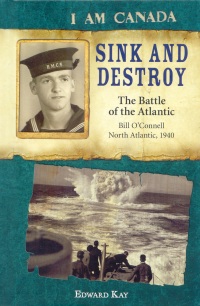| ________________
CM . . .
. Volume XXI Number 14 . . . . December 5, 2014
excerpt:
Billy O'Connell was raised in the small Ontario town of Iroquois on the banks of the St Lawrence River at a time when the Depression was a presence in the home almost like a third parent. Not surprising then that, as the tide of joblessness began to recede with the threat of war, he quit school and went to work on a lakeboat ferrying grain from Port Arthur and Fort William down to the port of Montreal. After war was declared, it was a short step from lakeboat to corvette. He lied about his age and enlisted in the Canadian Navy. Sink and Destroy gives a picture of life in the very stable, but hideously uncomfortable, corvettes as they did escort duty across the North Atlantic, guarding freighters carrying grain and other essential supplies across to beleaguered Britain. And back again, riding high and empty. Both ways they were harassed by German U-boats, especially in the "Black Pit" -- the mid-Atlantic air gap or 600-mile stretch of water where they were out of range for air cover from either side. Danger on the high seas was countered by good times ashore, and Bill was amazed at how friendly and welcoming the Scots were, and by contrast, just how much sailors were mistrusted, resented, and exploited in Halifax. Billy doesn't seem to have had any idea why this should be, but it was not surprising that it was while he was stationed in Greenock that he acquired a girl friend, the thoughts of whom sustained him during times at sea. Their story should have ended happily ever after, but this was wartime, and it didn't. Aileen's house was bombed, and the whole family who had made Bill so welcome were killed. As the historical note at the back of the book says, "When the war began, Canada's Navy, like its Army and Air Force, was small, understaffed and ill-equipped for a major conflict." Young Bill has some exceedingly caustic comments about Prime Minister Mackenzie King: "the cheap bastard, living in his dream world, betting against all odds that the war wouldn't come -- and that if it did it could be fought with hand-me-down equipment from the First World War." This, after failing to sink a U-boat that could have been destroyed if he'd had a proper gun. At least by this time in the war, Billís ship did have guns! The first corvette that Bill sailed across the Atlantic in came equipped with a grey-painted telegraph pole mounted on its prow! Why? "No more guns," he was told. Sink and Destroy gives a graphic picture of the uncomfortable, dangerous life on board these corvettes, of the difficulties encountered on shore, and a lot of thoughts about the war, itself, as it ground on to its far-from-inevitable conclusion. What it does not give is a real feeling of immediacy and excitement. So, while I learned a lot, and was certainly glad that Bill survived, I had no great sense of involvement in his story. Sink and Destroy will be enjoyed by those "into" war and armies, but for readers who want an adventure that keeps them flipping the pages, the book will be rewarding but a bit disappointing. Recommended. Mary Thomas lives in Winnipeg and works in elementary schools there. Her engineer father spent the war in Ottawa, turning sewing-machine factories into gun producers, and this book indicates why he was more use there than in the trenches.
To comment on this title or this review, send mail to cm@umanitoba.ca.
Copyright © the Manitoba Library Association. Reproduction for personal use is permitted only if this copyright notice is maintained. Any
other reproduction is prohibited without permission.
CM Home | Next Review | Table of Contents for This Issue - December 5, 2014 | Back Issues | Search | CM Archive | Profiles Archive |
